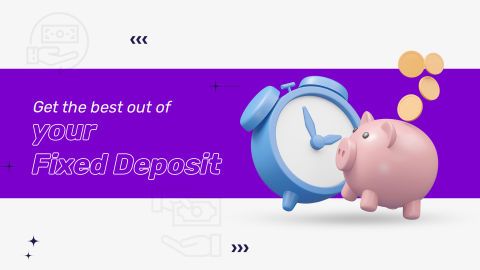A non-cumulative fixed deposit (FD) is a type of FD where the interest earned is paid out at regular intervals, such as monthly, quarterly, semi-annually, or annually, depending on the terms of the FD. In a non-cumulative FD, the interest does not get added to the principal amount, and the depositor receives periodic interest payments, which can serve as a source of regular income. This is in contrast to a cumulative FD, where the interest is compounded and paid out along with the principal amount at maturity. Non-cumulative FDs are suitable for individuals who require a steady stream of income from their investments.
What is a non-cumulative fixed deposit?
For a non-cumulative fixed deposit, the interest is payable monthly, quarterly, half-yearly, or annual. You can choose the interest payout frequency at the time of application and receive periodic payments every month, quarter, half-year, or year. The maturity amount decreases as the interest payout frequency increases as the interest rate drops and the power of compounding are curtailed.
With a non-cumulative FD, you can look forward to regular interest payouts for recurring expenses. Such an FD is suitable for people who need a steady income from interest payouts, such as pensioners. The tenor for a non-cumulative FD can range between 12 and 60 months.
Invest in a Bajaj Finance non-cumulative Fixed Deposit to receive generous payouts on your investments.
You can easily calculate the interest returns with the help of Bajaj Finance FD Calculator.
Features of Non-Cumulative Fixed Deposit
Non-cumulative fixed deposits offer investors a predictable and regular source of income. Here are some key features of these deposits:
- Interest Payout Frequency: Unlike cumulative FDs, where interest is compounded and paid out at maturity, non-cumulative FDs provide periodic interest payouts. Investors can choose from various payout frequencies, such as monthly, quarterly, semi-annually, or annually, based on their financial needs.
- Steady Income: Non-cumulative FDs are ideal for those who rely on a consistent income stream. They are particularly beneficial for retirees or individuals seeking to supplement their regular earnings with interest income.
- Fixed Interest Rate: The interest rate on non-cumulative FDs remains constant throughout the investment tenure, ensuring that investors know exactly how much they will earn at each payout interval.
- Tenure Options: Investors can select the tenure of their non-cumulative FDs based on their financial goals and liquidity requirements. FDs typically offer tenures ranging from a few months to several years.
Eligibility for Non-Cumulative Fixed Deposit
Eligibility criteria for non-cumulative fixed deposits are straightforward and are generally similar to those for regular FDs. Individuals, including residents, non-resident Indians (NRIs), and Hindu Undivided Families (HUFs), can invest in non-cumulative FDs. The specific eligibility requirements may vary among banks and financial institutions, so it's essential to check with the respective institution before investing.
How Non-Cumulative Fixed Deposit Works?
The operation of non-cumulative fixed deposits is relatively simple. Here's a step-by-step guide on how they work:
- Opening an Account: To start, individuals need to open a non-cumulative FD account with a bank or financial institution like Bajaj Finance.
- Choosing the Tenure: Investors should select the preferred tenure for their FD, keeping in mind their financial objectives and liquidity needs.
- Selecting the Payout Frequency: At the time of opening the FD account, investors decide how frequently they want to receive interest payouts. Common options include monthly, quarterly, semi-annually, or annually.
- Depositing Funds: Once the account is set up, investors deposit a lump sum amount into the FD account.
- Interest Payment: The FD issuer calculates and disburses the interest earnings as per the chosen frequency directly into the investor's bank account.
- Maturity: When the FD matures, the principal amount is returned to the investor, concluding the investment.
Documents Required for Non-Cumulative Fixed Deposits
The documentation required for opening a non-cumulative fixed deposit account typically includes:
- Proof of Identity: Aadhar card, passport, driver's license, or any other government-issued ID.
- Proof of Address: Utility bills, bank statements, or other documents showing the investor's residential address.
- Photographs: Passport-sized photographs of the investor.
- PAN Card: Permanent Account Number (PAN) card for tax-related purposes.
Cumulative versus non-cumulative FD
Cumulative and non-cumulative fixed deposits (FDs) are two popular investment options, each with its unique characteristics and advantages.
In a cumulative FD, the interest earned is reinvested with the principal amount, allowing it to compound over time. The interest is compounded periodically resulting in higher overall returns at maturity. Cumulative FDs are an excellent choice for long-term investors looking to maximize their returns. However, they do not provide regular interest payouts during the tenor.
Non-cumulative FDs, on the other hand, offer periodic interest payouts, providing a steady income stream to investors. These payouts can be monthly, quarterly, half-yearly, or annually, depending on the investor's choice. Non-cumulative FDs are suitable for individuals seeking regular income or those with short-term financial goals.
Choosing between cumulative and non-cumulative FDs depends on your financial objectives and cash flow needs.
Is Non-Cumulative Fixed Deposit the Right Choice for You?
Non-cumulative fixed deposits are suitable for specific financial situations and goals. Consider the following factors to determine if they are the right choice for you:
- Need for Regular Income: If you require a steady income source, such as during retirement, non-cumulative FDs can provide consistent interest payouts.
- Short- to Medium-Term Goals: Non-cumulative FDs are well-suited for short- to medium-term financial objectives, such as funding a vacation, buying a vehicle, or covering educational expenses.
- Risk Aversion: If you prioritize capital preservation and are risk-averse, non-cumulative FDs offer a secure investment option.
- Fixed Income Requirement: Individuals with fixed monthly or quarterly expenses can align their interest payout frequency with their financial obligations.
Things to Remember Before Investing in Non-Cumulative Fixed Deposit
Before investing in non-cumulative fixed deposits, consider the following:
- Tax Implications: Be aware of the tax implications associated with interest income, as it may be subject to taxation as per your applicable tax slab.
- Payout Frequency: Choose the interest payout frequency that aligns with your financial needs.
- Lock-in Period: Understand the tenure and lock-in period of your FD, as premature withdrawals may incur penalties.
Conclusion
In conclusion, non-cumulative fixed deposits provide a reliable means of generating regular income and are suitable for investors seeking stability and consistent returns. However, it's crucial to assess your financial goals and requirements to determine if non-cumulative FDs align with your investment strategy.



